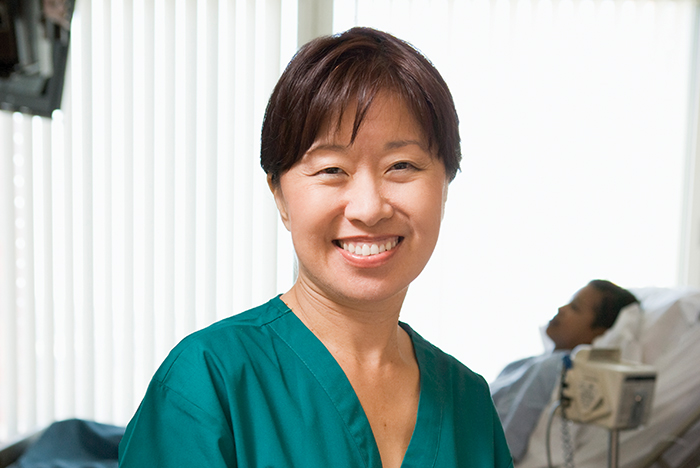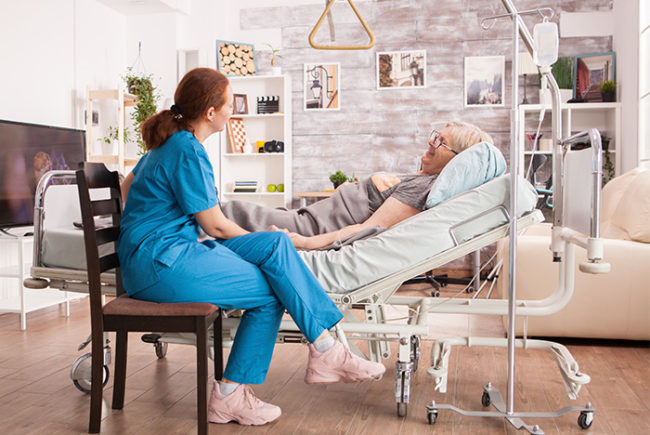
EVS professionals are members of the health care team with some of the most frequent and consistent patient contact.
Image by Getty Images
The cleanliness of the environment is often the first thing a patient notices when entering a hospital. That first impression may then serve as the foundation of the patient experience, which today is a recognized aspect of health care impacting HCAHPS scores, hospital margins, market share and staff morale.
Courtesy shown to patients also impacts the patient experience. Strategic support of environmental services (EVS) staff to ensure that they contribute to a positive patient experience is the focus of many hospital improvement projects.
Experience versus satisfaction
Although they are interconnected, patient satisfaction and patient experience are not the same. The entire hospitalization and how it is perceived by a patient represents patient experience. Patient satisfaction is determined by whether a patient’s expectations are met during hospitalization. Surveys to assess patient satisfaction include questions regarding whether the health care team members courteously and clearly communicate with the patient. This is where EVS professionals can have significant impact.
Another way to positively impact patient experience is for all members of the health care team, including EVS professionals, to understand and help mitigate the most commonly held patient fears. In a study of 1,000 patients by Colleen Sweeney, R.N., called “The Patient Empathy Project,” the No. 1 fear reported was infection. By providing a clean environment and reducing the risk of pathogen transmission, EVS professionals can help to mitigate this fear.
To allay patient fears in general, the Empathy Project recommends a combination of cleanliness, listening, respect and courtesy. The practical definition of empathy, according to the project, is looking the patient in the eyes and asking them what they need, then doing something about it. Empathy will go a long way to ensuring an exceptional patient experience.
The role of EVS
EVS professionals are members of the health care team with some of the most frequent and consistent patient contact. This affords them an opportunity to engage the patient with a brief and courteous greeting before thorough cleaning of the patient environment.
Scripting can assist EVS professionals in feeling more confident with patient greetings and in sharing information with patients regarding the role of EVS in the prevention of infection. It is important for EVS professionals and patients to understand how critical this role is.
For EVS staff, understanding their role in patient safety by reducing infection transmission risk can positively affect job satisfaction. It can also confer a level of confidence that supports them in responding to patients who might request that they “come back later or skip room cleaning.”
The job of EVS professionals has become progressively more technical and challenging with new and improved cleaning solutions and tools such as enhanced hydrogen peroxide, and microfiber cloths and mops. In addition, no-touch adjunctive technologies are becoming a fairly standard means of enhancing manual cleaning of the health care environment. These technologies include ultraviolet C wave (UV-C) disinfection and hydrogen peroxide (HP) vapor, and require specialized EVS training.
This need for specialized training in basic and advanced tools and methods is supported by the Association for the Health Care Environment (AHE) with a number of training and certification programs for EVS managers and staff. The training includes a focus on communication and why EVS professionals should take pride in the important role they play in patient safety and clinical quality improvement efforts.
The patients’ perception of cleanliness affects the patient experience and, in turn, the hospital’s brand and reputation. Because patients are more likely to recommend a hospital that prioritizes cleanliness, this has become a key performance improvement measure.
This is why there is such an emphasis placed by AHE on standardized assessment of the environment with audit practices that measure the cleanliness of high-touch surfaces. This also has been reported to promote a positive departmental morale and accountability for cleanliness.
EVS challenges
Patients will take their business where they will have the best experience, just like consumers of any other product or service. It’s also known from patient surveys that high-quality outcomes, including patient satisfaction, are associated with optimal reimbursement.
HCAHPS surveys are required by the Centers for Medicare & Medicaid Services (CMS), and results impact reimbursement. The survey is designed for adult hospital patients, except psychiatric patients. One of the survey questions measures patient satisfaction with the cleanliness of the hospital. Science supports this mandated survey, with evidence confirming the relationship of contaminated environmental surfaces in hospitals with transmission of pathogens that cause health care-associated infections.
While some hospitals recognize EVS staff for their important role in patient safety and patient experience, it is not yet the case in all locations. And even where it is acknowledged, often the staffing and resources to support the EVS department are insufficient. This can impact morale and performance of EVS departments.
Another big challenge facing EVS departments today is emphasis on a rapid turnaround time. There is throughput pressure from admitting and nursing departments for the fastest possible turnaround time. This can result in shortcuts in cleaning as well as less direct supervision.
The value and importance of the EVS department must be understood and considered by all departments, with the culture established by hospital leadership. Adequate EVS staffing, resourcing and sufficient turnaround times must be part of any equation designed to ensure high quality of patient care and experience.
Another long-standing challenge relates to environmental disinfectant contact time, also called “dwell time” or “kill time.” Here again when time is limited, the manufacturer’s recommended contact time may not always be followed, which can compromise the efficacy of the disinfectant. This is where product innovation can help. Environmental disinfectant products are increasingly coming to market with shorter contact times.
As noted, innovative no-touch technologies are being introduced in many hospitals to enhance the efficacy of manual cleaning. EVS professionals must learn how to operate these technologies, which poses a training challenge. Additionally, though showing promise in reducing infection risk, these technologies can increase turnaround time.
Accountability for cleaning also is an issue in many hospitals. In part due to increasing patient acuity, there is more equipment in use for patient care in all departments. Accountability for cleaning this equipment is often unclear and can result in equipment that is not cleaned or not cleaned often enough. This creates an increased risk of pathogen transmission between patients and an associated increase in infection risk.
Finally, due to pay and recognition issues and resulting low morale, many EVS departments experience a high rate of staff turnover. This, in turn, creates an increase in the resources required to train and retrain these staff and a risk of insufficiently trained staff and insufficiently cleaned environments.
Recipe for success
To ensure optimal EVS impact on patient experience, there are a few elements which, when combined, can be considered a recipe for success.
An initial gap analysis relative to EVS impact on patient experience can identify opportunities for improvement. This could be a paper-based survey or online survey, designed to measure the current status of elements that can affect EVS impact on patient experience.
These would include how comfortable EVS technicians are with patient interaction. For instance, is there a challenge with English as a second language? Is there any standard scripting in use to help support EVS interactions with patients? Additionally, it is important to determine the level of staff knowledge regarding the association of environmental cleaning and infection transmission risk. It would also be beneficial to assess the level of EVS staff morale and job satisfaction.
In addition to a survey of EVS staff, it is important to understand the baseline for patient satisfaction with the cleanliness of the hospital and with customer service. Not only is this important in terms of optimizing patient experience, but experts agree that measuring patient satisfaction can positively impact the quality improvement of care.
As noted, the primary patient satisfaction survey tool used in health care today is HCAHPS. This addresses experience and assessment of quality of care from the patient’s point of view.
Based on the gap analysis, an action plan can be created to support enhancing the EVS impact on patient experience. This might include EVS staff training. AHE offers a train-the-trainer program, enabling one designated EVS technician to receive certification in order to return and provide the same comprehensive training to all staff in the EVS department. This program includes a focus on customer service, scripting and simulation, all supporting optimal EVS and patient interaction.
It also might include developing or enhancing the process for assessing the quality of cleaning. There are a variety of tools available and in use by EVS departments to assess the quality of cleaning, including fluorescent markers and adenosine triphosphate (ATP) measurement.
It is abundantly clear that a clean environment is critical to a positive patient experience. Cleanliness is being considered by patients at every point in their health care journey. The appearance of the physical environment is vital to a patient’s perception and customer satisfaction is based on perception.
Another action plan element could be development of EVS staff scripting, if it is not already in use. Scripting is a simple tool that can enhance the quality of EVS interaction with patients. Scripting can be used in simulation for practice, which can increase EVS staff confidence and improve the quality of communication between EVS staff and patients.
This scripting and simulation easily can be added to both annual and ongoing EVS training programs. The scripts might include standard greetings, responses to patients who request postponing room cleaning, verbal encouragement of patient hand hygiene, sharing information regarding the EVS role in infection prevention, and inquiring whether the patient needs any assistance before leaving the room.
Finally, most hospitals can benefit from improved efforts to formally recognize EVS staff performance and escalating the acknowledgement to hospital executives. Gallup surveys find that only 33% of U.S. workers strongly agree that they receive recognition for doing a good job. And in a field such as EVS that is faced with high rates of turnover, this is not surprising, as studies indicate that employees who are not valued are twice as likely to resign from a position. Recognition and appreciation have been shown to result in better staff retention and increased quality of work by reinforcing and modeling better performance.
After the action plan is fully executed, an evaluation will help to determine the impact. This should ideally be an interdisciplinary endeavor with input from colleagues (e.g., nursing) and EVS staff, and should include analysis of quality assessment metrics (e.g., fluorescent marker, ATP scores, HCAHPS scores).
This is also the time to identify any unresolved issues and consider how to address them, as well as to develop a plan for sustaining gains.
A positive impact
Patient experience is affected by the interactions that patients have with the health care team, including with EVS staff. This provides EVS staff with an important opportunity to make a positive impact.
Additionally, a clean environment not only creates a positive first impression for patients, but reduces the risk of infection and the patient’s fear of infection.
Sue Barnes, R.N., CIC, FAPIC, is an independent infection prevention and control consultant based in San Mateo, Calif. She can be reached at sueabarnes@gmail.com.




